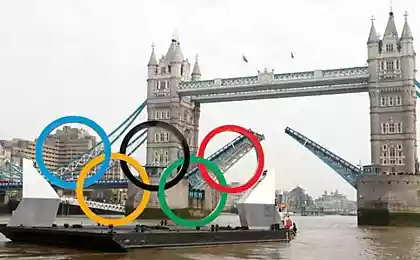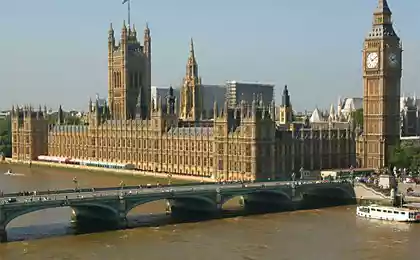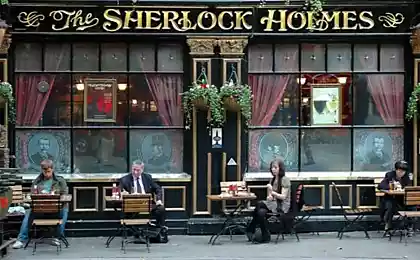1047
As in London, fought with the stench (12 photos)
Until the end of the XVI century Londoners used as such wells, large tanks, as well as directly to waters of the Thames and its tributaries. Tank filled with water channels. In this case, the rich citizens could make for a special payment pipes to their homes. In addition, many of the water delivered water trucks, even in 1496 created their own guild. In principle, quite a familiar sight for major cities of the length of history ...
In 1582 citizen Peter Maurice leased the northern arch of London Bridge and found in it a water wheel is driven by a pump to supply water to several blocks. This design caught a long time - until 1822. Twice modernized it, adding new water wheels.
Prior to the beginning of the XIX century sewage though, of course, fell into the Thames, but on the whole river to deal with them, dissolving and carrying away. However, that all changed in 1815, when the city government in the light of the expansion of the city and increase its population decided to prevent sewage discharge (not centralized, it did not yet exist, but individual pipes) into the river. Sanitation situation quickly became critical. The sharp rise in the number of inhabitants, as well as an increase in the number of horses without proper development of what is now called the infrastructure, not only leads to a deficiency of "convenience" (often one toilet fell on some houses), but also to the constant overflow of pit latrines (they were then in the city there were more than two hundred thousand). Content last just do not have time to clean, and sometimes hosts removable houses just saved on this.
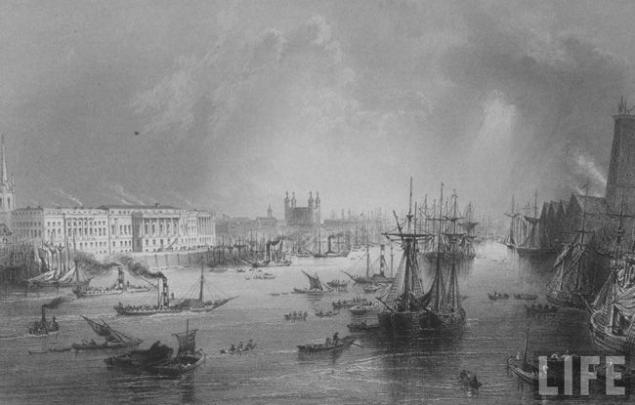
soon became common habitual in our era flush toilets that only increased the daily volume of waste water.
Sewerage, mixing with sewage plants and slaughterhouses, picking up trash on the road numerous, have openly flowed through rain gutters and any lowlands into the Thames. In that same river, where there are still many townspeople took water, including drinking and washing. After some time the permit to discharge sewage into the river was canceled, but the situation is out of control.
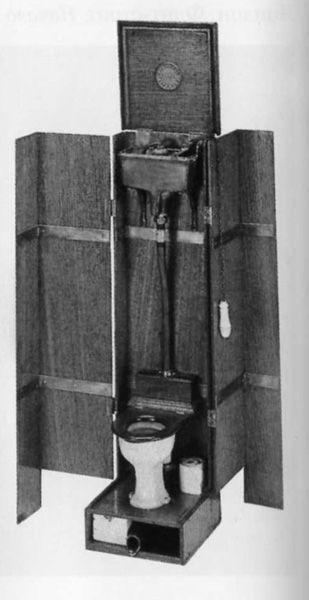
When in mid-century, the famous scientist Michael Faraday decided to take a ride on the Thames on a walking boat, he was struck by how polluted water. Here is what he wrote in the newspaper "The Times" July 7, 1855: "I broke a few white cards into pieces, soaked them to easily drowned, and in every place where the ship ashore, immerse them in water. She was so muddy that when immersed cards on the thickness of a finger in bright, sunny day they were completely indistinguishable. The smell of the river was such that it seemed as if we are sailing on the open sewer. "
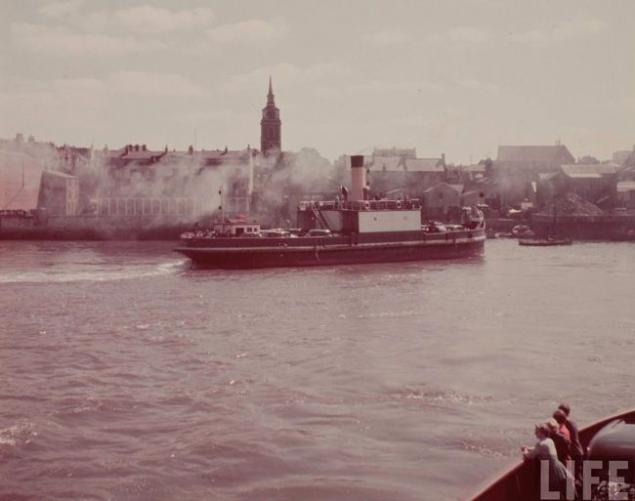
In some ways, the words were prophetic Faraday as three years after their publication in the "Times", sewage flowed into the Thames and the tide went first up the river to the city center, and then with the tide began to flow in the direction of Greenwich. Hot weather has exacerbated the situation - the water of the Thames and its tributaries beginning to bloom vigorously. The smell of the river was such that terrified even accustomed to a strong scent noses ordinary Londoners XIX century.
Released after low tide the beach was covered in sewage decomposes. Breathe in the city was absolutely nothing - the stench of the most adversely complemented dense smog, already generates suffocating London fog. In English literature, one can often find a comparison of summer days in 1858 with the well-known epidemic of plague XIV century - the Black Death, combined, however, with cholera, imported from the new colonies. In the history of this crisis came under the name of Great stench (The Great Stink). Londoners fell dead in the streets, and hospitals overwhelmed by patients, could not save the weakened grueling work and poor nutrition of people, because they themselves were in the affected area. The exact number of victims is unknown in those days, and will hardly ever found. Death in poor families was then commonplace: according to statistics, in British cities with a population of over 100 thousand. Man, life expectancy in the early days of the reign of Queen Victoria did not exceed 29 years.
Bitter humor of the time can be seen in the cartoon above, published in the London press in 1859.
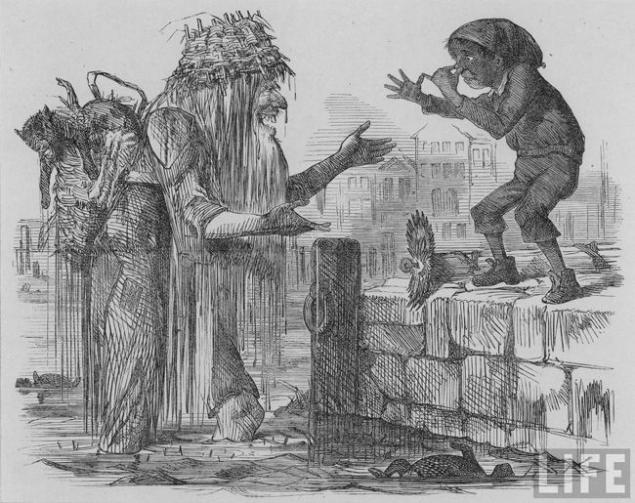
Along with ordinary citizens suffer even stronger world order. Of course, those who could afford to leave London and received. It is significant of all, however, escape the parliament of the newly prostroennogo famous building on the River Thames at Hampton Court, and the courts - in Oxford.
First, however, with the stench in the parliament tried to fight all impregnated curtains chlorine and dezinfektami. Soon, however, the author of the project building ventilation Speaker wrote that in such circumstances, it does not assume any responsibility for the newly embedded system.
Fleeing from the smell and bringing the matter to the nose scarves with rose water, the members of the House of Commons decided to immediately allocate money for the construction of a new sewerage and water supply. They passed a law obliging to implement the project as soon as possible. In the history of England, it was perhaps the only case where the decision of before the law took only 18 days.
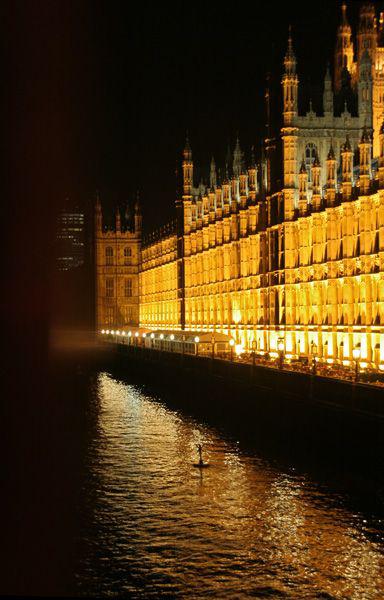
As a result of heavy rains flushed with Thames and its banks, removed acuteness of the problem, but even the most short-sighted politicians realized that defer to the construction of sewerage systems is impossible. In addition, in 1854 London physician John Snow proved that cholera, with 40 years of the XIX century, literally mows population of large cities in England, is directly related to water pollution, and not mythical miasma air, as previously thought. (Talking about the life of a simple family of the London end of the Victorian era, I mentioned that for a long time beer and ale consumed virtually instead of ordinary drinking water because of the poor quality of the latter. However, if people did not think about bacteria, but the more visible impurities. John Snow also investigated range of cholera in Soho and quickly discovered that the source of infection was drinking at the crossroads of the column, which had been poisoned water near the leak from the damaged sewer pipe.) However, the latest discovery is not all taken seriously, payback for what has become an epidemic, with interruptions lasted until the end of the 1860s.
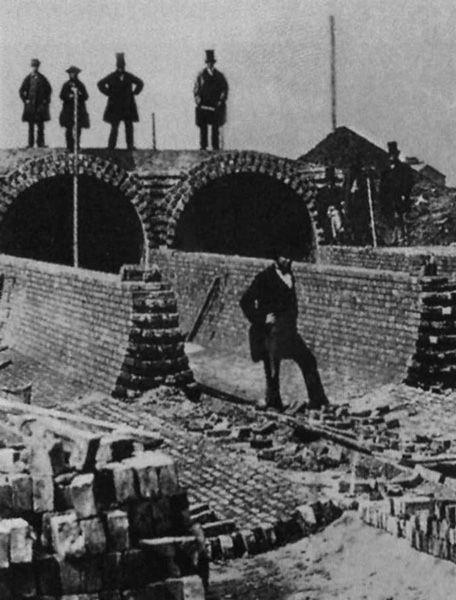
At the end of the same in 1855, a special council to choose among a lot of proposals on the competition circuit design their own chief engineer - Italian architect Joseph Bazalgetti (Joseph Bazalgette).
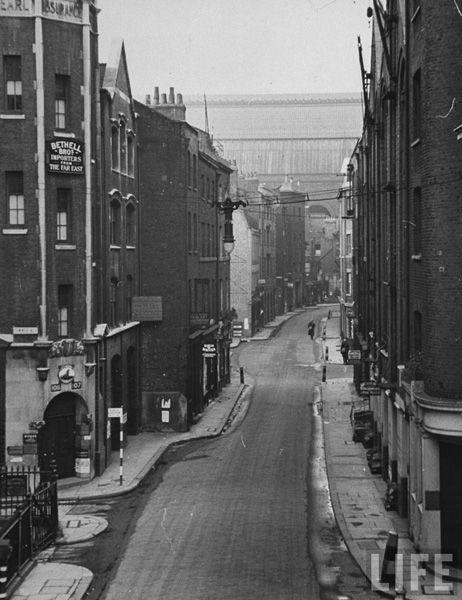
He decided to build five major interceptor systems, three - on the left (north) bank of the Thames, and two - on the right. They were supposed to prevent the ingress of sewage into the river and provide them reset located very close to the eastern edge of London Sea. Intercepting sewers to reduce the cost of building constructed directly in line with the Thames, after blocking it part of the caissons. Besides saving, it gave two positive effects. First, formed neat stone embankments, secondly, a straightening and narrowing the river bed made Thames run faster. Thus, the bottom was nice cleaned from piling up in it for centuries impurities. By the way, the project was not created with the "zero", work in this direction architect began in 1853, "inspired by" another cholera epidemic.
When the device caissons along coastlines Bazalgetti applied masonry and has been an innovator in the way connections bricks. Previously, they were placed in the mortar. However, it hardens very slowly and can not be applied to a wet surface. Therefore, the architect decided to use portland cement, invented in 1824 a bricklayer from Yorkshire. This type of cement used only for finishing, but Bazalgetti was convinced that he was perfect for the construction of sewers, because hardens even under water. Engineer ordered the masons to mix it with coarse sand, instead of the usual small, and even used for these purposes gravel. In other words, he applied for concrete mortar, which, incidentally, dropped the project.
Gravel is still visible in the joints between the bricks, and strengthening the occasional river, modern builders argue that the old masonry break very easily, it is still not cracks. After the wall was composed, and the boundary of the new shore began to correspond idea Bazalgetti, pumped water, and the resulting space is filled with an enormous amount of land, thereby extending the embankment at a considerable segment of the channel.
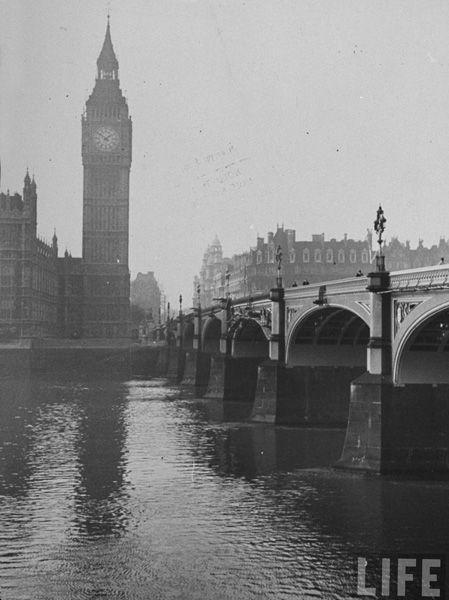
However, all these works are pale in comparison to everything themselves sewer tunnels that not only ran deeper than the bottom of the river, but also walked along it for 82 miles. The capacity of facilities is one hundred million gallons per day! One can only imagine the resistance of the builders who worked with the constant threat of falling from ladders when laying brick walls, either be covered with earth or flooded river or crushed by a horse in the dark endless corridor.
This is a rare picture, which shows multiple major London will take time - Railway (seems to Charing Cross Station), metro, water and, of course, sewage. Pay special attention to the fact that here you can see the steam locomotive that was used in the subway before its electrification.
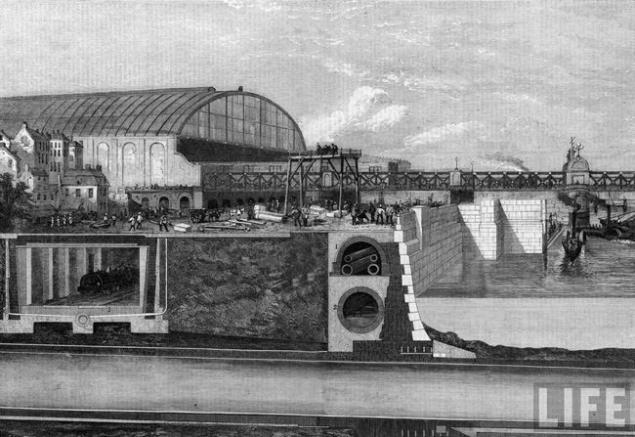
In the diagram, visible system of tunnels built under the project Bezalgetti. In any case, remember that the Thames near London, flowing from west to east.
Most of the construction work was carried out under the ground is completely transparent to the public, but when Bazalgetti build something on top, it was worthy of attention. For example, "Krossness» (Crossness) - station with elegant cast-iron staircases and four huge steam engines. Or very interesting from an architectural and engineering viewpoints station "Abbey Mills» (Abbey Mills) with eight steam engines, rises to the height of the contents of the sewer 42 feet. By the way, both of these stations have been recently restored and open for those wishing to enjoy the beauty of the production design of the XIX century.
Content sewage was collected in huge tanks to the east of London. For example, the area of the tank, the southern part of the operating system, up to 6, 5 acres at 17 feet depth. It contained a 27 million gallons of wastewater, which was discharged daily into the sea at low tide. By the way, a storage-pulsating principle allowed sewage works for a long time to manage without treatment facilities, the construction of which has already attended to only in the XX century.
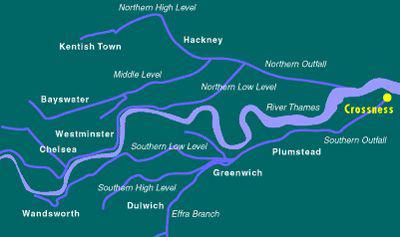
Key objects London sewer system were constructed for six years. In the ceremony starting April 4, 1865 did not disdain to attend the Prince of Wales - the future King Edward VII. Completely same project was implemented by 1870, it has since the Great London stench and really became a part of history. The cost of the work achieved absolutely fantastic sum of three million pounds. Sewer presented not only clean air of the British capital, but also showed the world what a Portland cement, immediately after this thing has found wide application in construction.
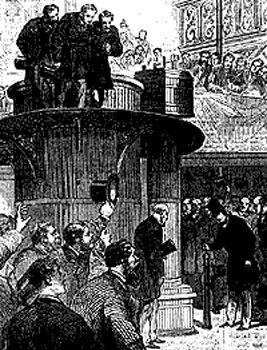
In 1999, that is, 140 years after the beginning of the construction of this massive structure, went inside Adam Hart-Davis, author of "What the Victorians did for us." According to him, he was fascinated by the magnificent state of masonry walls and fortress pipes, which, in spite of a steady stream of filth, still stand surprisingly reliable. However, here we can recall that sewage still did not protect London from cholera in the second half of the 1860s, when the poisoned water runoff inflow Thames filled reservoirs Eastern Water Company. However, this lesson has been learned, and the measures taken for all get rid of the British capital cholera outbreaks.
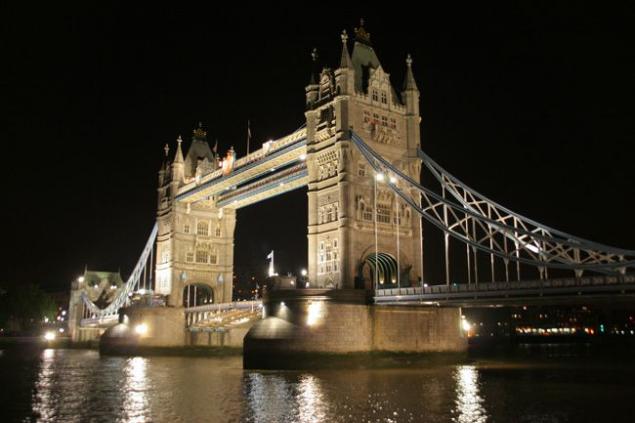
In 1582 citizen Peter Maurice leased the northern arch of London Bridge and found in it a water wheel is driven by a pump to supply water to several blocks. This design caught a long time - until 1822. Twice modernized it, adding new water wheels.
Prior to the beginning of the XIX century sewage though, of course, fell into the Thames, but on the whole river to deal with them, dissolving and carrying away. However, that all changed in 1815, when the city government in the light of the expansion of the city and increase its population decided to prevent sewage discharge (not centralized, it did not yet exist, but individual pipes) into the river. Sanitation situation quickly became critical. The sharp rise in the number of inhabitants, as well as an increase in the number of horses without proper development of what is now called the infrastructure, not only leads to a deficiency of "convenience" (often one toilet fell on some houses), but also to the constant overflow of pit latrines (they were then in the city there were more than two hundred thousand). Content last just do not have time to clean, and sometimes hosts removable houses just saved on this.

soon became common habitual in our era flush toilets that only increased the daily volume of waste water.
Sewerage, mixing with sewage plants and slaughterhouses, picking up trash on the road numerous, have openly flowed through rain gutters and any lowlands into the Thames. In that same river, where there are still many townspeople took water, including drinking and washing. After some time the permit to discharge sewage into the river was canceled, but the situation is out of control.

When in mid-century, the famous scientist Michael Faraday decided to take a ride on the Thames on a walking boat, he was struck by how polluted water. Here is what he wrote in the newspaper "The Times" July 7, 1855: "I broke a few white cards into pieces, soaked them to easily drowned, and in every place where the ship ashore, immerse them in water. She was so muddy that when immersed cards on the thickness of a finger in bright, sunny day they were completely indistinguishable. The smell of the river was such that it seemed as if we are sailing on the open sewer. "

In some ways, the words were prophetic Faraday as three years after their publication in the "Times", sewage flowed into the Thames and the tide went first up the river to the city center, and then with the tide began to flow in the direction of Greenwich. Hot weather has exacerbated the situation - the water of the Thames and its tributaries beginning to bloom vigorously. The smell of the river was such that terrified even accustomed to a strong scent noses ordinary Londoners XIX century.
Released after low tide the beach was covered in sewage decomposes. Breathe in the city was absolutely nothing - the stench of the most adversely complemented dense smog, already generates suffocating London fog. In English literature, one can often find a comparison of summer days in 1858 with the well-known epidemic of plague XIV century - the Black Death, combined, however, with cholera, imported from the new colonies. In the history of this crisis came under the name of Great stench (The Great Stink). Londoners fell dead in the streets, and hospitals overwhelmed by patients, could not save the weakened grueling work and poor nutrition of people, because they themselves were in the affected area. The exact number of victims is unknown in those days, and will hardly ever found. Death in poor families was then commonplace: according to statistics, in British cities with a population of over 100 thousand. Man, life expectancy in the early days of the reign of Queen Victoria did not exceed 29 years.
Bitter humor of the time can be seen in the cartoon above, published in the London press in 1859.

Along with ordinary citizens suffer even stronger world order. Of course, those who could afford to leave London and received. It is significant of all, however, escape the parliament of the newly prostroennogo famous building on the River Thames at Hampton Court, and the courts - in Oxford.
First, however, with the stench in the parliament tried to fight all impregnated curtains chlorine and dezinfektami. Soon, however, the author of the project building ventilation Speaker wrote that in such circumstances, it does not assume any responsibility for the newly embedded system.
Fleeing from the smell and bringing the matter to the nose scarves with rose water, the members of the House of Commons decided to immediately allocate money for the construction of a new sewerage and water supply. They passed a law obliging to implement the project as soon as possible. In the history of England, it was perhaps the only case where the decision of before the law took only 18 days.

As a result of heavy rains flushed with Thames and its banks, removed acuteness of the problem, but even the most short-sighted politicians realized that defer to the construction of sewerage systems is impossible. In addition, in 1854 London physician John Snow proved that cholera, with 40 years of the XIX century, literally mows population of large cities in England, is directly related to water pollution, and not mythical miasma air, as previously thought. (Talking about the life of a simple family of the London end of the Victorian era, I mentioned that for a long time beer and ale consumed virtually instead of ordinary drinking water because of the poor quality of the latter. However, if people did not think about bacteria, but the more visible impurities. John Snow also investigated range of cholera in Soho and quickly discovered that the source of infection was drinking at the crossroads of the column, which had been poisoned water near the leak from the damaged sewer pipe.) However, the latest discovery is not all taken seriously, payback for what has become an epidemic, with interruptions lasted until the end of the 1860s.

At the end of the same in 1855, a special council to choose among a lot of proposals on the competition circuit design their own chief engineer - Italian architect Joseph Bazalgetti (Joseph Bazalgette).

He decided to build five major interceptor systems, three - on the left (north) bank of the Thames, and two - on the right. They were supposed to prevent the ingress of sewage into the river and provide them reset located very close to the eastern edge of London Sea. Intercepting sewers to reduce the cost of building constructed directly in line with the Thames, after blocking it part of the caissons. Besides saving, it gave two positive effects. First, formed neat stone embankments, secondly, a straightening and narrowing the river bed made Thames run faster. Thus, the bottom was nice cleaned from piling up in it for centuries impurities. By the way, the project was not created with the "zero", work in this direction architect began in 1853, "inspired by" another cholera epidemic.
When the device caissons along coastlines Bazalgetti applied masonry and has been an innovator in the way connections bricks. Previously, they were placed in the mortar. However, it hardens very slowly and can not be applied to a wet surface. Therefore, the architect decided to use portland cement, invented in 1824 a bricklayer from Yorkshire. This type of cement used only for finishing, but Bazalgetti was convinced that he was perfect for the construction of sewers, because hardens even under water. Engineer ordered the masons to mix it with coarse sand, instead of the usual small, and even used for these purposes gravel. In other words, he applied for concrete mortar, which, incidentally, dropped the project.
Gravel is still visible in the joints between the bricks, and strengthening the occasional river, modern builders argue that the old masonry break very easily, it is still not cracks. After the wall was composed, and the boundary of the new shore began to correspond idea Bazalgetti, pumped water, and the resulting space is filled with an enormous amount of land, thereby extending the embankment at a considerable segment of the channel.

However, all these works are pale in comparison to everything themselves sewer tunnels that not only ran deeper than the bottom of the river, but also walked along it for 82 miles. The capacity of facilities is one hundred million gallons per day! One can only imagine the resistance of the builders who worked with the constant threat of falling from ladders when laying brick walls, either be covered with earth or flooded river or crushed by a horse in the dark endless corridor.
This is a rare picture, which shows multiple major London will take time - Railway (seems to Charing Cross Station), metro, water and, of course, sewage. Pay special attention to the fact that here you can see the steam locomotive that was used in the subway before its electrification.

In the diagram, visible system of tunnels built under the project Bezalgetti. In any case, remember that the Thames near London, flowing from west to east.
Most of the construction work was carried out under the ground is completely transparent to the public, but when Bazalgetti build something on top, it was worthy of attention. For example, "Krossness» (Crossness) - station with elegant cast-iron staircases and four huge steam engines. Or very interesting from an architectural and engineering viewpoints station "Abbey Mills» (Abbey Mills) with eight steam engines, rises to the height of the contents of the sewer 42 feet. By the way, both of these stations have been recently restored and open for those wishing to enjoy the beauty of the production design of the XIX century.
Content sewage was collected in huge tanks to the east of London. For example, the area of the tank, the southern part of the operating system, up to 6, 5 acres at 17 feet depth. It contained a 27 million gallons of wastewater, which was discharged daily into the sea at low tide. By the way, a storage-pulsating principle allowed sewage works for a long time to manage without treatment facilities, the construction of which has already attended to only in the XX century.

Key objects London sewer system were constructed for six years. In the ceremony starting April 4, 1865 did not disdain to attend the Prince of Wales - the future King Edward VII. Completely same project was implemented by 1870, it has since the Great London stench and really became a part of history. The cost of the work achieved absolutely fantastic sum of three million pounds. Sewer presented not only clean air of the British capital, but also showed the world what a Portland cement, immediately after this thing has found wide application in construction.

In 1999, that is, 140 years after the beginning of the construction of this massive structure, went inside Adam Hart-Davis, author of "What the Victorians did for us." According to him, he was fascinated by the magnificent state of masonry walls and fortress pipes, which, in spite of a steady stream of filth, still stand surprisingly reliable. However, here we can recall that sewage still did not protect London from cholera in the second half of the 1860s, when the poisoned water runoff inflow Thames filled reservoirs Eastern Water Company. However, this lesson has been learned, and the measures taken for all get rid of the British capital cholera outbreaks.

The title of "Miss World 2010" went to 18-year-old Alexandria Mills.
Wedding in style latex (14 photos)
